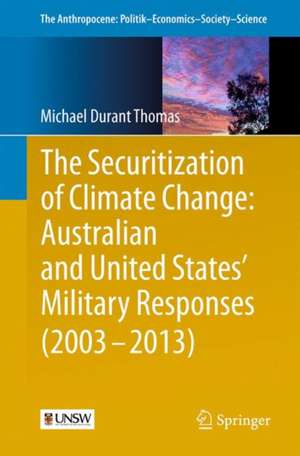The Securitization of Climate Change: Australian and United States' Military Responses (2003 - 2013): The Anthropocene: Politik—Economics—Society—Science, cartea 10
Autor Michael Durant Thomasen Limba Engleză Paperback – 2 aug 2017
This book examines how the armed forces of the United States and Australia have responded to the threat posed by climate change to national security. Drawing on established securitisation frameworks (‘Copenhagen’ and ‘Paris’ Schools), the author uses a combination of quantitative and qualitative techniques to systematically examine more than 3,500 speeches, policies and doctrinal articles since 2003. Importantly, the author undertakes an examination of the intersection between the political and the military spheres, probing the question of how ideology has influenced the military’s uptake on the issue. In this context, the author identifies the difficulty of an ostensibly apolitical institution responding to what has become both a hyper-political issue and an unprecedented security threat. A close examination of the key political actors – their intent, outlook and political mandate for broader climate action – is therefore crucial to understanding the policy freedom and constraints within which military leaders operate. The book consists of eight chapters divided into four parts, focusing on: perspectives and methodological insights; empirical case studies; case study comparison; and concluding observations.
•Offers a rare and systematic examination of military climate policy by a military officer from Australia
•Identifies a divergence of Australian military climate policy from that of the US military during the Obama Administration
•Develops a unique method that quantifies climate security, enabling a graphical representation for quick and ready reference ideally suited to policy-makers
Din seria The Anthropocene: Politik—Economics—Society—Science
-
 Preț: 403.48 lei
Preț: 403.48 lei -
 Preț: 361.89 lei
Preț: 361.89 lei -
 Preț: 380.63 lei
Preț: 380.63 lei - 20%
 Preț: 583.00 lei
Preț: 583.00 lei -
 Preț: 390.46 lei
Preț: 390.46 lei - 5%
 Preț: 361.80 lei
Preț: 361.80 lei -
 Preț: 379.09 lei
Preț: 379.09 lei -
 Preț: 384.48 lei
Preț: 384.48 lei -
 Preț: 380.84 lei
Preț: 380.84 lei -
 Preț: 451.26 lei
Preț: 451.26 lei -
 Preț: 391.40 lei
Preț: 391.40 lei -
 Preț: 430.21 lei
Preț: 430.21 lei -
 Preț: 387.75 lei
Preț: 387.75 lei -
 Preț: 378.34 lei
Preț: 378.34 lei -
 Preț: 418.29 lei
Preț: 418.29 lei - 5%
 Preț: 399.91 lei
Preț: 399.91 lei -
 Preț: 428.07 lei
Preț: 428.07 lei -
 Preț: 386.39 lei
Preț: 386.39 lei -
 Preț: 392.75 lei
Preț: 392.75 lei -
 Preț: 424.22 lei
Preț: 424.22 lei -
 Preț: 384.09 lei
Preț: 384.09 lei -
 Preț: 429.61 lei
Preț: 429.61 lei -
 Preț: 381.98 lei
Preț: 381.98 lei -
 Preț: 415.83 lei
Preț: 415.83 lei -
 Preț: 382.18 lei
Preț: 382.18 lei - 15%
 Preț: 647.40 lei
Preț: 647.40 lei - 18%
 Preț: 1123.04 lei
Preț: 1123.04 lei - 15%
 Preț: 579.34 lei
Preț: 579.34 lei - 18%
 Preț: 802.46 lei
Preț: 802.46 lei - 18%
 Preț: 944.51 lei
Preț: 944.51 lei -
 Preț: 383.33 lei
Preț: 383.33 lei -
 Preț: 383.33 lei
Preț: 383.33 lei -
 Preț: 383.33 lei
Preț: 383.33 lei -
 Preț: 380.07 lei
Preț: 380.07 lei -
 Preț: 413.66 lei
Preț: 413.66 lei -
 Preț: 417.52 lei
Preț: 417.52 lei
Preț: 389.49 lei
Nou
Puncte Express: 584
Preț estimativ în valută:
74.53€ • 78.09$ • 61.61£
74.53€ • 78.09$ • 61.61£
Carte tipărită la comandă
Livrare economică 11-25 aprilie
Preluare comenzi: 021 569.72.76
Specificații
ISBN-13: 9783319496573
ISBN-10: 3319496573
Pagini: 295
Ilustrații: XXIV, 295 p. 22 illus., 19 illus. in color.
Dimensiuni: 155 x 235 mm
Greutate: 0.45 kg
Ediția:1st ed. 2017
Editura: Springer International Publishing
Colecția Springer
Seria The Anthropocene: Politik—Economics—Society—Science
Locul publicării:Cham, Switzerland
ISBN-10: 3319496573
Pagini: 295
Ilustrații: XXIV, 295 p. 22 illus., 19 illus. in color.
Dimensiuni: 155 x 235 mm
Greutate: 0.45 kg
Ediția:1st ed. 2017
Editura: Springer International Publishing
Colecția Springer
Seria The Anthropocene: Politik—Economics—Society—Science
Locul publicării:Cham, Switzerland
Cuprins
1.The Strategic Dissonance of Australia’s Climate Security Response.- 2.Climate Security: The Physical Basis.- 3. Climate Security in Europe, the US and the UN Security Council.- 4.Case Study Aim and Method.- 5.Climate Security Case Study: Australia.- 6. Climate Security Case Study: United States.- 7. Climate Securitisation in the US and Australia: Discussion.- 8.Conclusion.
Textul de pe ultima copertă
This book examines how the armed forces of the United States and Australia have responded to the threat posed by climate change to national security. Drawing on established securitisation frameworks (‘Copenhagen’ and ‘Paris’ Schools), the author uses a combination of quantitative and qualitative techniques to systematically examine more than 3,500 speeches, policies and doctrinal articles since 2003. Importantly, the author undertakes an examination of the intersection between the political and the military spheres, probing the question of how ideology has influenced the military’s uptake on the issue. In this context, the author identifies the difficulty of an ostensibly apolitical institution responding to what has become both a hyper-political issue and an unprecedented security threat. A close examination of the key political actors – their intent, outlook and political mandate for broader climate action – is therefore crucial to understanding the policy freedom and constraints within which military leaders operate. The book consists of eight chapters divided into four parts, focusing on: perspectives and methodological insights; empirical case studies; case study comparison; and concluding observations.
•Offers a rare and systematic examination of military climate policy by a military officer from Australia
•Identifies a divergence of Australian military climate policy from that of the US military during the Obama Administration
•Develops a unique method that quantifies climate security, enabling a graphical representation for quick and ready reference ideally suited to policy-makers
Caracteristici
Offers a rare and systematic examination of military climate policy by a military officer Identifies a divergence of Australian military climate policy from that of the US military Develops a unique method that quantifies climate security, enabling a graphical representation for quick and ready reference ideally suited to policy makers Includes supplementary material: sn.pub/extras





